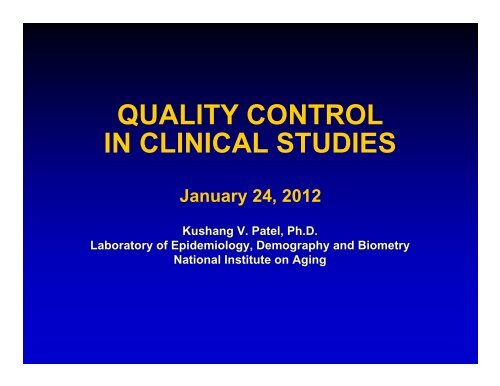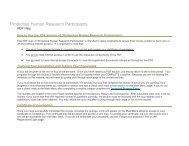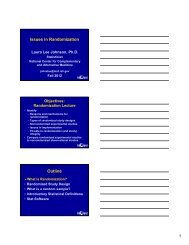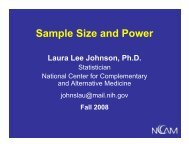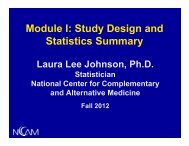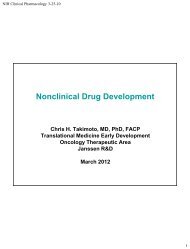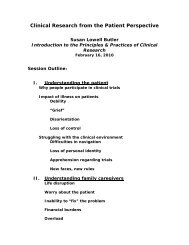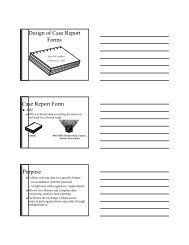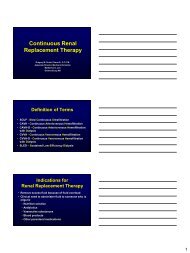Quality Control in Clinical Trials
Quality Control in Clinical Trials
Quality Control in Clinical Trials
Create successful ePaper yourself
Turn your PDF publications into a flip-book with our unique Google optimized e-Paper software.
QUALITY CONTROL<br />
IN CLINICAL STUDIES<br />
January 24, 2012<br />
Kushang V. Patel, Ph.D.<br />
Laboratory of Epidemiology, Demography and Biometry<br />
National Institute on Ag<strong>in</strong>g<br />
g
Outl<strong>in</strong>e<br />
I. Need for <strong>Quality</strong> <strong>Control</strong><br />
II.<br />
III.<br />
IV.<br />
<strong>Quality</strong> <strong>Control</strong> of Cl<strong>in</strong>ical Procedures<br />
Identify<strong>in</strong>g Appropriate Data for <strong>Quality</strong> <strong>Control</strong><br />
Study Procedures for <strong>Quality</strong> <strong>Control</strong><br />
V. Data Edit<strong>in</strong>g<br />
VI.<br />
Bias Result<strong>in</strong>g from Poor <strong>Quality</strong> <strong>Control</strong>
I. Need for <strong>Quality</strong> <strong>Control</strong><br />
(after Hulley SB and Cumm<strong>in</strong>gs SR, Design<strong>in</strong>g<br />
Cl<strong>in</strong>ical Research, Williams and Wilk<strong>in</strong>s,<br />
Baltimore,1988)<br />
A. To assure quality of data and avoid<br />
systematic bias or random error lead<strong>in</strong>g to<br />
erroneous or un<strong>in</strong>terpretable results<br />
Bias: Any process at any stage of <strong>in</strong>ference<br />
which tends to produce results or<br />
conclusions that differ systematically from<br />
the truth
B. Miss<strong>in</strong>g data<br />
1. Can be disastrous if affects large<br />
proportion of measurements<br />
2. If miss<strong>in</strong>g i <strong>in</strong> non-random way (and<br />
almost always is) leads to bias <strong>in</strong><br />
results<br />
3. Often biases toward null but not<br />
always<br />
4. Examples: self-report of disease<br />
status, <strong>in</strong>come, pulmonary function<br />
test, treadmill exercise tolerance<br />
test<strong>in</strong>g<br />
5. Best way to deal with miss<strong>in</strong>g data is<br />
to prevent them from occurr<strong>in</strong>g
C. Inaccurate or imprecise data<br />
1. Often rema<strong>in</strong> undiscovered, especially<br />
if measurements made by more than<br />
one person<br />
2. Typically due to <strong>in</strong>appropriate<br />
technique (poor calibration, biased<br />
<strong>in</strong>terrogation, rushed or sloppy<br />
measures), often distributed randomly<br />
with regard to participant<br />
characteristics
3. Less often but more concern<strong>in</strong>g are<br />
systematic differences <strong>in</strong> measurement<br />
techniques associated with participant<br />
characteristics: obese or unfit<br />
persons allowed to hold hand rails <strong>in</strong><br />
exercise test<strong>in</strong>g; persons with<br />
emphysema permitted to shorten<br />
exhalation time <strong>in</strong> spirometry test<strong>in</strong>g
II. <strong>Quality</strong> <strong>Control</strong> of Cl<strong>in</strong>ical i l Procedures<br />
A. Steps that precede study<br />
1. Develop manual of operations<br />
a. Clear operational def<strong>in</strong>itions of<br />
eligibility, recruitment,<br />
measurement procedures<br />
b. Standardized <strong>in</strong>struments and<br />
forms<br />
c. Approaches to analyz<strong>in</strong>g data<br />
2. Tra<strong>in</strong> and certify research team<br />
3. Establish procedures for monitor<strong>in</strong>g<br />
data quality
Formal Certification Procedures<br />
1. Determ<strong>in</strong>e dur<strong>in</strong>g gplann<strong>in</strong>g gphase which<br />
components of study require certification<br />
Include not only exam<strong>in</strong>ation procedures<br />
but also <strong>in</strong>terview<strong>in</strong>g, data entry<br />
procedures, consent<strong>in</strong>g and<br />
randomization, <strong>in</strong>terventions, blood<br />
collection and process<strong>in</strong>g<br />
2. Certification form that is kept on file<br />
3. Certification checklist
LIFE Components Requir<strong>in</strong>g Certification<br />
Short Physical Performance Battery<br />
Blood Pressure<br />
Weight, Height<br />
Waist Circumference<br />
400 m walk test<br />
Medication Inventory<br />
Grip Strength<br />
Blouse/Shirt Test<br />
Lateral Mobility Task (WFU)<br />
Cognitive Tests (WFU and Stanford)<br />
Blood Collection<br />
Blood Process<strong>in</strong>g<br />
Interview<strong>in</strong>g (HRQL and MMSE)<br />
CHAMPS<br />
Data Entry<br />
Behavioral Run-<strong>in</strong> Adm<strong>in</strong>istration and Assessment<br />
Physical Activity Intervention<br />
Successful Ag<strong>in</strong>g Intervention<br />
Program Coord<strong>in</strong>ator<br />
Note that for all components, the follow<strong>in</strong>g tasks must be completed:<br />
(1) Attendance at the LIFE centralized tra<strong>in</strong><strong>in</strong>g session or tra<strong>in</strong><strong>in</strong>g by someone certified <strong>in</strong> the measurement/procedure;<br />
(2) Required read<strong>in</strong>g: Manual of Procedures Chapters 1 (Protocol) and 24 (<strong>Quality</strong> <strong>Control</strong>).<br />
(3) Plus additional items listed on the certification forms (Appendix A).
Certification/Recertification (example)<br />
Seated Blood Pressure<br />
_________________________________<br />
__ __ __<br />
Name<br />
1. Attendance at central tra<strong>in</strong><strong>in</strong>g session ___________ or<br />
Date<br />
Local tra<strong>in</strong><strong>in</strong>g by a staff member certified <strong>in</strong> the procedure.<br />
__________ _____________________________________________<br />
Date Name of Tra<strong>in</strong>er<br />
Description of local tra<strong>in</strong><strong>in</strong>g:<br />
_________________________________________________________<br />
_________________________________________________________<br />
_________________________________________________________<br />
1.Become familiar study website.<br />
2.Required Read<strong>in</strong>g<br />
Chapter 1, Protocol<br />
Chapter 4, General Procedures<br />
Chapter 6, Screen<strong>in</strong>g<br />
Chapter 8, Follow-up Visits<br />
Staff ID<br />
Chapter 16, Physical Measures<br />
Chapter 24, <strong>Quality</strong> <strong>Control</strong><br />
4. Conduct 3 blood pressures, record on the Blood Pressure, Radial Pulse & Weight Form.<br />
Tra<strong>in</strong>er uses and completes the Seated BP Certification Checklist dur<strong>in</strong>g observation of the<br />
procedure.<br />
5. Date of Certification ______________________________<br />
_________________________________ _________________________________<br />
Signature of Program Coord<strong>in</strong>ator Date Signature of Pr<strong>in</strong>cipal Investigator Date
Certification/Recertification Checklist (example)<br />
Seated Blood Pressure<br />
_________________________________<br />
Name<br />
__ __ __<br />
Staff ID<br />
Dur<strong>in</strong>g Procedure:<br />
1. Keeps participant warm, relaxed and comfortable<br />
2. Discourages participant from talk<strong>in</strong>g except to voice discomfort or confusion about <strong>in</strong>structions<br />
Observes the Follow<strong>in</strong>g Procedural Steps:<br />
1.Assembles proper materials and equipment:: standard mercury sphygmomanometer, 4 cuff sizes,<br />
measur<strong>in</strong>g tape, cosmetic mark<strong>in</strong>g pencil<br />
2.Greets participant and reviews purpose, time requirement and procedure.<br />
3.Seats participant <strong>in</strong> proper position - both feet flat on floor, right forearm rest<strong>in</strong>g on table<br />
4.Determ<strong>in</strong>es appropriate cuff size by follow<strong>in</strong>g protocol for measurement of arm circumference.<br />
Measures length of arm from acromion to olecranon process, marks midpo<strong>in</strong>t on arm. Measures arm<br />
circumference at mid-po<strong>in</strong>t, determ<strong>in</strong>es cuff size from MOP chart<br />
5.Records arm circumference, cuff size and arm measured on data form<br />
6.Measures and records radial pulse<br />
7. Places cuff properly with center of bladder over the brachial artery and cuff at the level of participant's<br />
heart<br />
8.Palpates brachial artery and estimates MIP<br />
9.Confirms participant is relaxed and comfortable and rem<strong>in</strong>ds of the need to be seated quietly for 5<br />
m<strong>in</strong>utes prior to the measurement<br />
10.Observes the 5 m<strong>in</strong>utes of relaxed sitt<strong>in</strong>g<br />
11.Obta<strong>in</strong>s 2 blood pressure measures with a 30 second <strong>in</strong>terval between end of first read<strong>in</strong>g and<br />
beg<strong>in</strong>n<strong>in</strong>g of second read<strong>in</strong>g<br />
12.Records both BP read<strong>in</strong>gs correctly on the data forms<br />
13.Communicates appropriately with participant regard<strong>in</strong>g a normal or an alert BP<br />
Comments:__________________________________________________________________________<br />
Observer:______________________________ Date Observed:________________
B. Steps dur<strong>in</strong>g study<br />
1. Conduct quality control procedures<br />
on regular schedule throughout the<br />
study<br />
2. Provide steady and visible<br />
leadership<br />
3. Hold regular staff meet<strong>in</strong>gs<br />
4. Reward staff for f<strong>in</strong>d<strong>in</strong>g quality<br />
control "opportunities"<br />
"<br />
5. Avoid cast<strong>in</strong>g blame which<br />
encourages staff to hide errors
6. Ma<strong>in</strong>ta<strong>in</strong> m<strong>in</strong>imum schedule of<br />
performances of procedures (e.g.,<br />
at least once per week) to ma<strong>in</strong>ta<strong>in</strong><br />
certification<br />
7. Recertify research team periodically<br />
8. Tabulate measures by technicians,<br />
compare variability, means
III. Identify<strong>in</strong>g appropriate data for quality<br />
control<br />
A. Cost of controll<strong>in</strong>g everyth<strong>in</strong>g is<br />
prohibitive<br />
B. May need less attention <strong>in</strong> bl<strong>in</strong>ded,<br />
randomized cl<strong>in</strong>ical trials as random<br />
errors should be distributed evenly<br />
between treatment groups<br />
C. Focus on patient t safety factors, key<br />
exposure variables, and outcome<br />
measures
1. Patient safety<br />
a. Consent forms and consent<br />
process<br />
b. Integrity of randomization scheme<br />
c. Effects and side-effects of<br />
treatment (blood pressure <strong>in</strong><br />
antihypertensive trial, coagulation<br />
measures <strong>in</strong> anticoagulation trial,<br />
etc.)<br />
d. Drug adm<strong>in</strong>istration (correct<br />
drug and dosage, correct code<br />
on participant bottle)
2. Major risk factors such as smok<strong>in</strong>g,<br />
alcohol <strong>in</strong>take, cholesterol level<br />
3. Subcl<strong>in</strong>ical or cl<strong>in</strong>ical disease<br />
assessments<br />
a. Ultrasound measurements of<br />
atherosclerosis: central read<strong>in</strong>g,<br />
bl<strong>in</strong>ded d to participant<br />
i t<br />
characteristics, duplicate measures<br />
to assess <strong>in</strong>ter- and <strong>in</strong>tra-reader<br />
reproducibility
. Tissue diagnosis of cancer:<br />
duplicate read<strong>in</strong>gs of all or sample<br />
of pathology specimens<br />
IV. Study Procedures for <strong>Quality</strong> <strong>Control</strong><br />
A. Spot checks or repeats of <strong>in</strong>terviews,<br />
exam f<strong>in</strong>d<strong>in</strong>gs, etc.<br />
B. Repeat of tests (EKGs, laboratory tests)<br />
1. Same reader or lab bl<strong>in</strong>ded to subject<br />
2. Different readers or labs
C. Check forms for omissions or major<br />
errors while subject still <strong>in</strong> cl<strong>in</strong>ic<br />
i<br />
1. No errors or transpositions of ID<br />
number<br />
2. ID number, name code, study name<br />
on each page<br />
3. No miss<strong>in</strong>g entries or faulty skip<br />
patterns<br />
4. Entries legible<br />
5. Values of key variables with<strong>in</strong><br />
permissible range<br />
6. Values of key variables are consistent<br />
with each other: hysterectomy y or<br />
estrogen use <strong>in</strong> men
B. Program computer to flag miss<strong>in</strong>g or outof-range<br />
values<br />
C. Ensure accuracy of participant i t ID number<br />
with check digit or duplicate entry<br />
D. Enter data <strong>in</strong> duplicate or check accuracy<br />
of entry by hand <strong>in</strong> random sample
E. Exam<strong>in</strong>e frequency distributions<br />
periodically to identify aberrant values or<br />
less than expected degree of variability<br />
F. Credos<br />
1. <strong>Quality</strong> control problems will occur.<br />
a. Have a system <strong>in</strong> place that will<br />
identify them<br />
b. Fix them as early as possible<br />
2. Data which are collected without any<br />
ongo<strong>in</strong>g quality checks are best left<br />
uncollected
V. Data edit<strong>in</strong>g<br />
A. Should be completed prior to data<br />
analysis, though h often errors crop up only<br />
once data beg<strong>in</strong> to be used<br />
B. Internal consistency and validity checks<br />
should be developed<br />
1. Detect record<strong>in</strong>g, cod<strong>in</strong>g, entry errors<br />
(prostate problems <strong>in</strong> women)<br />
2. Identify <strong>in</strong>appropriate codes
C. Types of errors<br />
1. Non-normative (clearly wrong) errors-<br />
usually easy to detect<br />
a. Inconsistent or illegal codes<br />
(for yes/no or 0/1 data, sex = 3;<br />
death = 4, etc.)
. Miss<strong>in</strong>g values (f<strong>in</strong>d out why<br />
miss<strong>in</strong>g-- must have ongo<strong>in</strong>g<br />
edit<strong>in</strong>g of forms, best done<br />
immediately after completion while<br />
participant still available)<br />
c. Outliers-- plot and exam<strong>in</strong>e (see<br />
below<br />
2. Normative errors<br />
a. Data entry, transcription errors<br />
b. Extremely difficult to detect<br />
t<br />
1. Check each value with data<br />
form or record
2. Enter data twice and compare<br />
files-- unlikely to make same<br />
data entry error twice<br />
3. Take random sample and verify<br />
with data form or record<br />
D. Identification of outliers<br />
1. Widely differ<strong>in</strong>g values for one or a few<br />
<strong>in</strong>dividuals requires scrut<strong>in</strong>iz<strong>in</strong>g data to<br />
be sure no cod<strong>in</strong>g, data entry or<br />
record<strong>in</strong>g errors occurred
2. Outlier test (Tukey)<br />
a. Rank data, divide <strong>in</strong>to percentiles<br />
(quartiles)<br />
b. Identify 25th, 75th percentiles,<br />
difference between them<br />
(<strong>in</strong>terquartile range)<br />
c. Def<strong>in</strong>e upper limit as 75th<br />
percentile plus <strong>in</strong>terquartile range<br />
d. Def<strong>in</strong>e lower limit as 25th percentile<br />
m<strong>in</strong>us <strong>in</strong>terquartile til range<br />
e. Reanalyze without outliers, report<br />
both
3. Easier to exclude data if reason for<br />
extreme value is known<br />
4. Prudent judgment should prevail<br />
VI. Bias <strong>in</strong> Cl<strong>in</strong>ical <strong>Trials</strong>: Special Issues <strong>in</strong> QC<br />
A. M<strong>in</strong>imal requirements for a bias-free<br />
RCT<br />
1. Establish comparable study groups<br />
which are free of selection bias
2. Use standard treatment procedures<br />
which are reproducible<br />
3. Develop data collection schedule<br />
where probability of observ<strong>in</strong>g an<br />
event, given that it has occurred, is the<br />
same for all patients<br />
B. Standardization as a means of bias<br />
control<br />
1. Manual of operations<br />
2. Description of treatment procedure<br />
3. Standard def<strong>in</strong>itions
4. Standard equipment<br />
5. Standardized data forms with check<br />
lists<br />
C. Checks for bias<br />
1. Periodic checks on basel<strong>in</strong>e<br />
comparability of study groups<br />
2. Breakdowns <strong>in</strong> the random allocation<br />
process<br />
3. Differential rate of treatment refusals<br />
4. Differential rate of dropouts<br />
5. Unnecessary unmask<strong>in</strong>g
6. Questionnaire to check on efficacy of<br />
mask<strong>in</strong>g at end of study<br />
7. Protocol violations which are<br />
differential by treatment group<br />
8. Differences <strong>in</strong> variance of read<strong>in</strong>gs by<br />
treatment group<br />
D. "Correction" for bias<br />
1. No method of adjustment available<br />
2. Early detection important<br />
3. Purg<strong>in</strong>g of data may be necessary
4. Stopp<strong>in</strong>g of trial may be necessary<br />
5. Report<strong>in</strong>g <strong>in</strong> publications is essential<br />
E. Don’t rush <strong>in</strong>to field work (observational<br />
studies and RCT’s)<br />
s).<br />
Take adequate time to plan QC activities<br />
and to properly p tra<strong>in</strong> staff.


